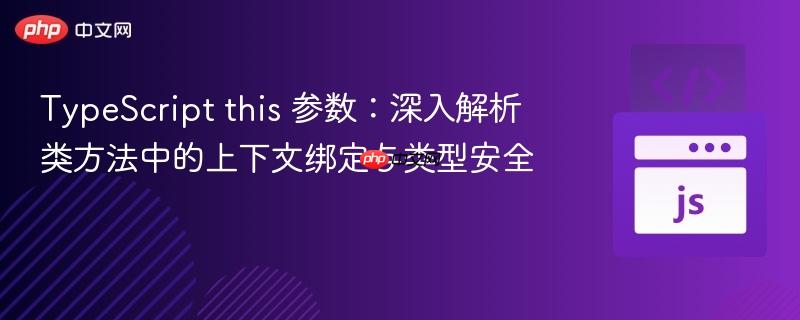
在 javascript 中,this 关键字的行为是动态的,取决于函数的调用方式。这在大型应用中常常导致混淆和错误。typescript 引入了 this 参数(例如 getname(this: myclass)),它并非运行时参数,而是一种编译时类型提示,用于明确指定方法内部 this 关键字所预期的类型。
当你在一个方法签名中声明 this: MyClass 时,你是在告诉 TypeScript 编译器:这个方法期望在 MyClass 实例的上下文中被调用。如果 this 的实际上下文与 MyClass 的结构不兼容,编译器就会报错,从而在早期发现潜在的运行时错误。
考虑以下 TypeScript 代码片段:
class MyClass {
x: string = "Class value";
getName(this: MyClass) {
return this.x;
}
}
// 创建 MyClass 实例
const obj1 = new MyClass();
console.log(obj1.getName()); // 正常调用,this 绑定到 obj1
// 创建一个普通 JS 对象,并直接赋值 MyClass 的方法
const obj2 = { x: 'Object Value', getName: obj1.getName };
// 正常工作,不会报错
console.log(obj2.getName());在这个例子中,obj2.getName() 的调用之所以没有报错,是因为 TypeScript 的结构化类型系统。尽管 obj2 并不是 MyClass 的实例,但它的结构 {x: string; getName: (this: MyClass) => string;} 与 MyClass 的结构是兼容的。具体来说,obj2 包含一个 string 类型的 x 属性,这满足了 getName 方法中 this: MyClass 所期望的 this.x 访问。
当 obj2.getName() 被调用时,JavaScript 的运行时机制会将 this 绑定到 obj2。由于 obj2 的结构满足 MyClass 的要求(至少在 getName 方法访问 this.x 的层面),TypeScript 编译器认为这种调用是类型安全的。
现在,我们来看一个会导致错误的情况:
class MyClass {
x: string = "Class value";
getName(this: MyClass) {
return this.x;
}
}
const obj1 = new MyClass();
// 将方法赋值给一个新变量(解构)
const a = obj1.getName;
// 调用会报错
a();尝试运行 a() 会导致以下 TypeScript 错误:
The 'this' context of type 'void' is not assignable to method's 'this' of type 'MyClass'.(2684)
这个错误揭示了 JavaScript this 绑定的一个核心行为:当一个方法被解构并赋值给一个独立的变量时(例如 const a = obj1.getName;),它就失去了与原始对象 obj1 的隐式绑定。当 a() 被独立调用时,在严格模式下,其 this 上下文会默认为 undefined。
TypeScript 编译器看到 getName 方法声明了 this: MyClass,但它发现 a() 调用时的 this 上下文是 void (代表 undefined)。由于 void 类型与 MyClass 类型不兼容,编译器便会发出错误,提醒开发者 this 上下文不匹配。
this 参数的类型检查是基于 TypeScript 的结构化类型兼容性原则的。这意味着,只要一个对象的结构包含了 this 参数所期望的所有成员(及其正确类型),TypeScript 就会认为它是兼容的。
示例:x 属性类型不匹配
如果 obj2 的结构与 MyClass 不兼容,即使方法签名相同,TypeScript 也会报错:
class MyClass {
x: string = "Class value";
getName(this: MyClass) {
return this.x;
}
}
const obj1 = new MyClass();
// obj2 的 x 属性类型为 number,与 MyClass 的 string 不兼容
const obj2 = { x: 123, getName: obj1.getName };
// 尝试调用会报错
// console.log(obj2.getName());此时的错误信息会是:
The 'this' context of type '{ x: number; getName: (this: MyClass) => string; }' is not assignable to method's 'this' of type 'MyClass'.
Types of property 'x' are incompatible.
Type 'number' is not assignable to type 'string'.(2684)这明确指出,虽然 obj2 有一个 x 属性,但其类型 number 与 MyClass 期望的 string 不匹配,因此整个 this 上下文被认为是不兼容的。
为了避免 this 上下文丢失导致的错误,可以采用以下几种策略:
使用箭头函数作为类属性: 箭头函数会词法绑定 this,即 this 的值在函数定义时就已经确定,而不是在调用时。
class MyClass {
x: string = "Class value";
// 箭头函数作为类属性
getArrowName = () => {
return this.x; // this 始终指向 MyClass 实例
}
}
const obj1 = new MyClass();
const b = obj1.getArrowName;
console.log(b()); // 正常工作使用 Function.prototype.bind() 方法: bind() 方法会创建一个新函数,该新函数在调用时会将 this 关键字设置为提供的值。
class MyClass {
x: string = "Class value";
getName(this: MyClass) {
return this.x;
}
}
const obj1 = new MyClass();
const boundGetName = obj1.getName.bind(obj1);
console.log(boundGetName()); // 正常工作在调用时提供上下文: 直接通过对象调用方法 (obj.method()) 或使用 call() / apply() 方法显式设置 this。
class MyClass {
x: string = "Class value";
getName(this: MyClass) {
return this.x;
}
}
const obj1 = new MyClass();
console.log(obj1.getName()); // 直接通过对象调用
const anotherContext = { x: "Another Value" };
// 使用 call/apply 显式设置 this
console.log(obj1.getName.call(anotherContext)); // 正常工作,因为 anotherContext 结构兼容TypeScript 中的 this 参数是一个强大的工具,它通过编译时类型检查,为 JavaScript 中动态且难以预测的 this 行为带来了急需的类型安全。
理解这些概念对于编写健壮、可维护的 TypeScript 代码至关重要,尤其是在处理事件处理器、回调函数或将类方法作为参数传递的场景中。
以上就是TypeScript this 参数:深入解析类方法中的上下文绑定与类型安全的详细内容,更多请关注php中文网其它相关文章!

每个人都需要一台速度更快、更稳定的 PC。随着时间的推移,垃圾文件、旧注册表数据和不必要的后台进程会占用资源并降低性能。幸运的是,许多工具可以让 Windows 保持平稳运行。




Copyright 2014-2025 https://www.php.cn/ All Rights Reserved | php.cn | 湘ICP备2023035733号